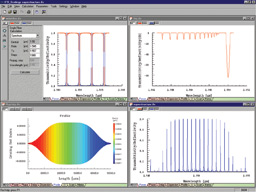Fiber Bragg Grating (FBG) and More
Emerging as a de facto standard over the last decade, OptiGrating has delivered powerful and user-friendly design software for modeling integrated and fiber optic devices that incorporate optical gratings. OptiGrating uses the Coupled Mode Theory to model the light and enable analysis and synthesis of gratings. A complex grating is approximated by a sequence of uniform segments, and analyzed by connecting the segments with the well-known Transfer Matrix Method. This gives the designer the information needed to test and optimize grating designs.
A complex grating is approximated by a sequence of uniform segments, and analyzed by connecting the segments with the well-known Transfer Matrix Method. This gives the designer the information needed to test and optimize grating designs.
Fiber Bragg Grating sensors are some of the most versatile photonics components available today. OptiGrating allows users to simulate an FBG and more by approximating a complex grating with sequenced uniform segments. These segments are then analyzed with the Transfer Matrix Methods.
Applications:
- WDM add/drop, narrow and broadband fiber and waveguide filters
- Fiber Bragg reflectors
- EDFA gain flattening elements
- Dispersion compensators for fiber communications
- Sideband suppression using grating apodization
- Fiber and waveguide sensors
- Long Period Gratings with coupling to cladding modes


FAQs
Is optical grating software compatible with other optical design tools?
Yes, OptiGrating can easily be integrated with other Optiwave tools, such as OptiSystem for transmission layer simulations and OptiInstrument, to accurately measure and test designs for practical applications.
What is Fiber Bragg Grating (FBG) used for?
An FBG has many applications, both in research and for commercial purposes:
Optical Filtering: FBGs can be used to selectively transmit light through fiber, allowing researchers to block specific wavelengths. This can be used to study different types of radiation and light.
Temperature Sensors: Fiber Bragg Grating sensors are commonly used in temperature sensing due to their innate sensitivity. This is done by measuring changes in the refraction index due to heat.
Monitoring: FBG can be used to measure conditions in harsh environments, where manual observation might not be possible. This includes: monitoring pressure changes in reactors, temperature measurements in power generators, and stress measurements of aviation components.
Can non-experts use optical grating software?
You don’t need to be a photonics expert to use OptiGrating. Our detailed manuals and videos offer step-by-step instructions for newcomers and experts alike. For more assistance with Fiber Bragg Grating (FBG), you can visit the forums or contact the Optiwave team.

